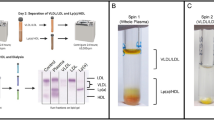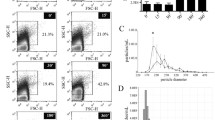Abstract
Ultracentrifugation (UC) is the method most often employed for separation and quantification of lipoproteins. Because this procedure requires expensive laboratory equipment, a large volume of fresh sample and an inordinate amount of time, it may not be ideal for routine clinical/experimental use. The aim of the current study was to evaluate a method which combines selective precipitation (HDL-P) and immunoseparation (LDL-I) for the rapid and reliable isolation of high density lipoproteins (HDL) and low density lipoproteins (LDL) specifically for vitamin E and carotenoid determination within these fractions. Cholesterol and triacylglycerol concentrations within the HDL and LDL were also determined to enable expression of vitamin E and carotenoid concentrations per gram of lipid. Isolation of lipoproteins by UC was used as the reference method (HDL-UC/LDL-UC). There were no significant differences between methods for α-and γ-tocopherol in LDL and HDL. Carotenoids measured in HDL and LDL were comparable between the methods. The exception was higher lutein/zeaxanthin concentration in HDL-P and LDL-I compared to HDL-UC and LDL-UC, respectively. Additionally, lycopene concentration was significantly lower in LDL-I compared to LDL-UC. In comparing vitamin E and carotenoid values in lipoproteins separated from fresh and frozen plasma by the direct method, there was no difference in α-tocopherol or the majority of carotenoids measured. In conclusion, a combination of selective precipitation and immunoseparation of fresh or frozen plasma for subsequent α-and γ-tocopherol analyses provides an accurate and reliable alternative to lipoprotein separation by UC. Additionally, carotenoid concentrations in HDL separated by selective precipitation and analyses of α-and β-carotenes and β-cryptoxanthin in LDL separated by immunoseparation are also reliable, while lycopene and lutein/zeaxanthin concentrations in LDL-I are not readily comparable to LDL-UC.
Similar content being viewed by others
Abbreviations
- HDL:
-
high density lipoproteins
- HDL-P:
-
HDL isolated by selective precipitation
- HDL-UC:
-
HDL isolated by sequential ultracentrifugation
- HPLC:
-
high-performance liquid chromatography
- LDL:
-
low density lipoprotein
- LDL-I:
-
LDL isolated by immunoseparation
- LDL-UC:
-
LDL isolated by sequential ultracentrifugation
- TG:
-
triacylglycerol
- UC:
-
ultracentrifugation
- VLDL:
-
very low density lipoproteins
References
Belcher, J.D., McNamara, J.R., Grinstead, G.F., Nader, R., Warnick, G.R., Bachorik, P., and Frantz, I. (1994)Laboratory Measurement of Lipids, Lipoproteins and Apolipoproteins, pp. 107–123, AACC Press, Washington.
Warnick, G.R., Cheung, M.C., and Albers, J.J. (1979) Comparison of Current Methods for High-Density Lipoprotein Cholesterol Quantitation,Clin. Chem. 25, 596–604.
Weiland, H., and Seidel, D. (1983) A Simple Specific Method for Precipitation of Low Density Lipoproteins,J. Lipid Res. 24, 904–909.
Clevidence, B.A., and Lehman, J. (1989) Alpha- and Gamma-Tocopherol Levels in Lipoproteins Fractionated by Affinity Chromatography,Lipids 24, 137–140.
McNamara, J.R., Cole, T.G., Contois, J.H., Ferguson, C.A., Ordovas, J.M., and Schaefer, E.J. (1995) Immunoseparation Method for Measuring Low-Density Lipoprotein Cholesterol Directly from Serum Evaluated,Clin. Chem. 41, 232–240.
Warnick, G.R., Benderson, J., and Albers, J.J. (1982) Dextran Sulfate-Mg2+ Precipitation Procedure for Quantitation of High-Density Lipoprotein Cholesterol,Clin. Chem. 28, 1379–1388.
Barua, A.B., Furr, H.C., Janick-Buckner, D., and Olson, J.A. (1993) Simultaneous Analysis of Individual Carotenoids, Retinol, Retinyl Esters, and Tocopherols in Serum by Isocratic Non-Aqueous Reversed-Phase HPLC,Food Chemistry 46, 419–424.
Carcelain, G., David, F., Lepage, S., Bonnefont-Rousselot, D., Delattre, J., Legrand, A., Peynet, J., and Troupel, S. (1992) Simple Method for Quantifying α-Tocopherol in Low-Density+Very-Low-Density Lipoproteins and in High-Density Lipoproteins.Clin. Chem. 38, 1792–1795.
Nanjee, N.M., and Miller, N.E. (1990) Evaluation of Long-Term Frozen Storage of Plasma for Measurement of High-Density Lipoprotein and Its Subfractions by Precipitation,Clin. Chem. 36, 783–788.
Demacker, P.N., and Jansen, A.P. (1983) Stability of High-Density-Lipoprotein Cholesterol in Frozen Sera,Clin. Chem. 29, 567–568.
Stokes, M.Y., Salmond, C.E., Carpenter, L.M., and Welby, T.J. (1986) Stability of Total Cholesterol, High-Density Lipoprotein Cholesterol, and Triglycerides in Frozen Sera,Clin. Chem. 32, 995–999.
McNamara, J.R., Huang, C., Massov, T., Leary, E.T., Warnick, G.R., Rubins, H.B., Robins, S.J., and Schaefer, E.J. (1994) Modification of the Dextran-Mg2+ High-Density Lipoprotein Cholesterol Precipitation Method for Use with Previously Frozen Plasma,Clin. Chem. 40, 233–239.
Kronenberg, F., Lobentanz, E.M., König, P., Utermann, G., and Dieplinger, H. (1994) Effect of Sample Storage on the Measurement of Lipoprotein[a], Apolipoproteins B and A-IV, Total and High Density Lipoprotein Cholesterol and Triglycerides,J. Lipid Res 35, 1318–1328.
Bachorik, P.S., Walker, R.E., and Kwiterovich, P.O. (1982) Determination of High Density Lipoprotein-Cholesterol in Human Plasma Stored at−70°C,J. Lipid Res. 23, 1236–1242.
Driskell, W.J., Neese, J.W., Bryvant, C.C., and Bashor, M.M. (1982) Measurement of Vitamin A and E in Human Serum by High-Performance Liquid Chromatography,J. Chromatogr. 231, 439–444.
Driskell, W.J., Lackey, A.D., Hewett, J.S., and Bashor, M.M. (1985) Stability of Vitamin A in Frozen Sera,Clin. Chem. 31, 871–872.
Craft, N.E., Brown, E.D., and Smith, J.C. (1988) Effects of Storage and Handling Conditions on Concentrations of individual Carotenoids, Retinol, and Tocopherol in Plasma,Clin. Chem. 34, 44–48.
Comstock, G.W., Alberg, A.J., and Helzlsouer, K.J. (1993), Reported Effects of Long-Term Freezer Storage on Concentrations of Retinol, β-carotene, and α-tocopherol in Serum or Plasma Summarized,Clin. Chem. 39, 1075–1078.
Clevidence, B.A., and Ballard-Barbash, R. (1991) Tocopherol-Contents of Lipoproteins from Frozen Plasma Separated by Affinity Chromatography,Lipids 26, 723–728.
Author information
Authors and Affiliations
About this article
Cite this article
Vogel, S., Contois, J.H., Couch, S.C. et al. A rapid method for separation of plasma low and high density lipoproteins for tocopherol and carotenoid analyses. Lipids 31, 421–426 (1996). https://doi.org/10.1007/BF02522929
Received:
Revised:
Accepted:
Issue Date:
DOI: https://doi.org/10.1007/BF02522929




